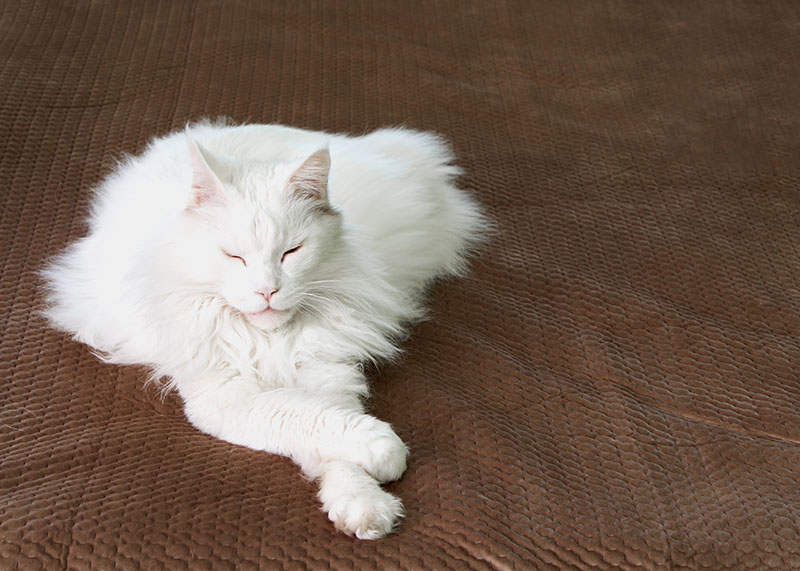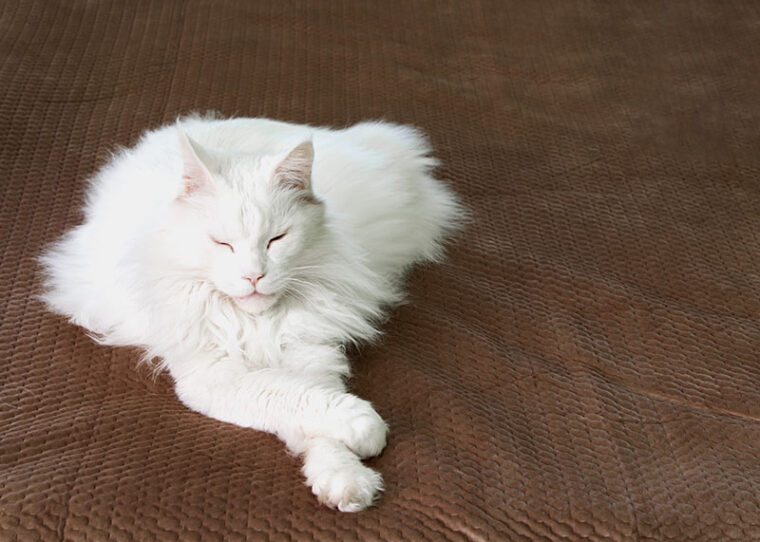- November 21, 2023
Are All White Cats Deaf? Vet-Reviewed Facts & FAQ



The information is current and up-to-date in accordance with the latest veterinarian research.
Since white cats are commonly linked to deafness, it’s natural that prospective parents of white cats might be concerned about these cats’ auditory health. While it’s true that all-white cats are at higher risk of deafness than cats of other colors, it’s not true that every single white cat is deaf. Let’s explore this further.

Deafness in White Cats: The Numbers
Research has been conducted on the issue of hereditary deafness in white cats, and it was discovered that 17% to 22% of non-blue-eyed white cats are born deaf.1 As for white cats with one blue eye, 40% are born deaf, and the most likely white cats to be born deaf are those with two blue eyes. 65%–85% of these cats experience deafness, which is a pretty huge number.
This research shows that, while deafness is especially prevalent in blue-eyed, white cats and, to a lesser extent, in cats with non-blue eyes or one blue eye, not every white cat will be born deaf.

What Causes Deafness in White Cats?
In cats that inherit deafness, degeneration takes place in the inner ear shortly after a kitten is born. This is caused by an autosomal dominant gene (W) that results in a white coat and, in some cases, deafness because it’s a multi-effective gene (pleiotropic).
Every cat with this gene will be born white, but not necessarily born deaf because the gene’s penetrance for deafness and blue eyes is what’s termed “incomplete”. Cats affected by deafness can experience deafness in both ears or, in some cases, in just one ear.

The 5 Interesting Facts About Deafness in White Cats
1. Deafness Can Be Very Subtle
If you have a white deaf cat, you may never know that they’re deaf because it’s not always obvious, especially if the cat is only deaf in one ear. Signs to look out for include not responding to their name or to toys that make a noise (like a squeaker toy), sleeping through loud, sudden noises like bangs, having an extra keen sense of smell, sensitivity to temperature, and sleeping a lot.

2. There Are Multiple Causes of Deafness
Deafness can be genetically inherited, or it can be caused by other factors, including certain medications, toxins, infectious diseases, tumors in the ear, injury to the ear, and ear inflammation. Older cats also become more prone to deafness.
3. Cats Deaf in One Ear Have a Special Trait
If a cat has one blue eye and is deaf in one ear, the deaf ear will be on the same side as the blue eye.
4. Deaf Cats Can Live Happy Lives
Being deaf doesn’t stop a cat from enjoying a long, happy life and being a wonderful companion to you. You can contribute to this by ensuring your deaf cat stays indoors, as roaming outdoors could open them up to a number of dangers—even more so than cats with full hearing. For example, deaf cats can’t hear approaching cars and potential predators.
5. You Can Still Communicate with Your Deaf Cat
Though your cat can’t hear you, you can get your cat’s attention via the vibrations made when you move. For example, if you want to wake up your cat, you can move something on the couch. This causes a vibration that your cat will be able to feel.
Cats can also feel vibrations caused when you clap or stomp your feet, so you can perform these actions if you need to get their attention. The most important thing to remember is that you should never approach a deaf cat from the back when they have no idea you’re coming—this could seriously startle them. Visual cues (like motioning the cat to come to you) can also help you communicate with your deaf cat.


Final Thoughts
To recap, not all white cats are deaf, but inherited deafness is certainly prevalent in white cats, especially those with two blue eyes. Nevertheless, this doesn’t mean that a deaf cat can’t make an amazing friend and enjoy a great quality of life, so don’t let deafness put you off adopting a lovely white kitty!
Featured Image Credit: Kreminska, Shutterstock
Tags
What do you think?
Related Articles

New Puppy Checklist: Gear You’ll Need for Your New Dog
Getting a new puppy is really exciting, but before you welcome them home, it’s important to prepare your space for them. Since puppies need a

How Big Do Mini Poodles Get? Vet Reviewed Average Weight & Growth Chart – Dogster
The information is current and up-to-date in accordance with the latest veterinarian research. Learn more » When you buy a Miniature Poodle, you might not

Can Police Dogs Smell Nicotine? Vet Verified Facts & Info – Dogster
The information is current and up-to-date in accordance with the latest veterinarian research. Learn more » While cigarette sales have been declining steadily for decades,

How Old Is 5 in Dog Years? Vet-Approved Guide to Each Size of Dog – Dogster
The information is current and up-to-date in accordance with the latest veterinarian research. Learn more » A common method for calculating a dog’s age is

